Finland
Finland
This article is about the country. For other uses, see Finland (disambiguation).
Republic of Finland
 Flag
Flag Coat of arms
Coat of arms
Anthem:
Maamme (Finnish)
Vårt land (Swedish)
(English: "Our Land")
Duration: 47 seconds.
0:47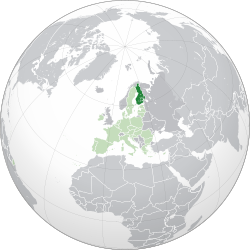 Show globe
Show globe
Show map of Europe
Show all
Location of Finland (dark green)
– in Europe (green & dark grey)
– in the European Union (green) – [Legend]
Capital
and largest city
Helsinki
 60°10′15″N 24°56′15″EOfficial languagesFinnishSwedish
60°10′15″N 24°56′15″EOfficial languagesFinnishSwedish- Recognized national languagesSamiKarelianFinnish KaloFinnish Sign LanguageFinland-Swedish Sign Language
- Ethnic groups (2021)[1][2]91.5% Finns[note 1]
- 8.5% others
- Religion (2021)[3]68.6% Christianity
- 66.6% Lutheranism
- 1.1% Orthodoxy
- 0.9% other Christian
- 30.6% no religion
- 0.8% other
- Demonym(s)FinnishFinn
GovernmentUnitary parliamentary republic[4]• President
Sauli Niinistö• Prime Minister
Petteri Orpo• Speaker of the Parliament
Jussi Halla-ahoLegislatureParliamentIndependence from Russia• Establishment of Grand Duchy of Finland under the rule of Russian Empire
29 March 1809• Declaration of full independence
6 December 1917• Finnish Civil War
January – May 1918• Constitution established
17 July 1919• Winter War
30 November 1939 – 13 March 1940• Continuation War
25 June 1941 – 19 September 1944• Joined the EU
1 January 1995• Joined NATO
4 April 2023Area• Total
338,145[5] km2 (130,559 sq mi) (65th)• Water (%)
9.71 (2015)[6]Population• 2023 estimate 5,604,558[7] (114th)• Density
5,604,558[7] (114th)• Density
16.4/km2 (42.5/sq mi) (213th)GDP (PPP)2023 estimate• Total $335.760 billion[8] (59th)• Per capita
$335.760 billion[8] (59th)• Per capita $59,869[8] (24th)GDP (nominal)2023 estimate• Total
$59,869[8] (24th)GDP (nominal)2023 estimate• Total $305.689 billion[8] (48th)• Per capita
$305.689 billion[8] (48th)• Per capita $54,507[8] (16th)Gini (2022)
$54,507[8] (16th)Gini (2022) 26.6[9]
26.6[9]
lowHDI (2021) 0.940[10]
0.940[10]
very high · 11thCurrencyEuro (€) (EUR)Time zoneUTC+2 (EET)• Summer (DST)
- UTC+3 (EEST)Date formatdd.mm.yyyy[11]Driving siderightCalling code+358ISO 3166 codeFIInternet TLD.fi, .axa, .eubThe .ax domain is used in Åland.
- The .eu domain is also used, as it is shared with other European Union member states.
Finland (Finnish: Suomi [ˈsuo̯mi] ⓘ; Swedish: Finland [ˈfɪ̌nland] ⓘ), officially the Republic of Finland (Finnish: Suomen tasavalta; Swedish: Republiken Finland; listen to allⓘ),[note 2] is a Nordic country in Northern Europe. It borders Sweden to the northwest, Norway to the north, and Russia to the east, with the Gulf of Bothnia to the west and the Gulf of Finland to the south, opposite Estonia. Finland covers an area of 338,145 square kilometres (130,559 sq mi)[5] and has a population of 5.6 million. Helsinki is the capital and largest city. The vast majority of the population are ethnic Finns. Finnish and Swedish are the official languages, with Swedish being the native language of 5.2% of the population.[12] Finland's climate varies from humid continental in the south to boreal in the north. The land cover is predominantly boreal forest biome, with more than 180,000 recorded lakes.[13][14]
Finland was first settled around 9000 BC after the last Ice Age.[15] During the Stone Age, various cultures emerged, distinguished by different styles of ceramics. The Bronze Age and Iron Ages were marked by contacts with other cultures in Fennoscandia and the Baltic region.[16] From the late 13th century, Finland became part of the Swedish Empire as a result of the Northern Crusades. In 1809, as a result of the Finnish War, Finland was captured from Sweden and became a Grand Duchy of Finland, an autonomous state ruled by the Russian Empire. During this period, Finnish art flourished and the idea of full independence began to take hold. In 1906, Finland became the first European state to grant universal suffrage, and the first in the world to give all adult citizens the right to run for public office.[17][note 3] Following the Russian Revolution of 1917, Finland declared its full independence. In 1918 the young nation was divided by the Finnish Civil War. During World War II, Finland fought against the Soviet Union in the Winter War and the Continuation War, and later against Nazi Germany in the Lapland War. As a result, it lost parts of its territory but retained its independence.
Finland remained a largely agricultural country until the 1950s. After World War II, it industrialised quickly and established an advanced economy, with a welfare state built on the Nordic model. This allowed the country to experience overall prosperity and high per capita income.[18] During the Cold War, Finland officially embraced a policy of neutrality. Since then, it has become a member of the European Union in 1995, the Eurozone in 1999, and NATO in 2023. Finland is a member of various international organisations, such as the United Nations, the Nordic Council, the Schengen Area, the Council of Europe, the World Trade Organization, and the Organisation for Economic Co-operation and Development (OECD). The nation performs exceedingly well in national performance metrics, including education, economic competitiveness, civil liberties, quality of life, and human development.[19][20][21][22]
History
Main article: History of Finland
Prehistory
Main article: History of Finland § Prehistory
The area that is now Finland was settled in, at the latest, around 8,500 BC during the Stone Age towards the end of the last glacial period. The artefacts the first settlers left behind present characteristics that are shared with those found in Estonia, Russia, and Norway.[23] The earliest people were hunter-gatherers, using stone tools.[24]
The first pottery appeared in 5200 BC, when the Comb Ceramic culture was introduced.[25] The arrival of the Corded Ware culture in Southern coastal Finland between 3000 and 2500 BC may have coincided with the start of agriculture.[26] Even with the introduction of agriculture, hunting and fishing continued to be important parts of the subsistence economy.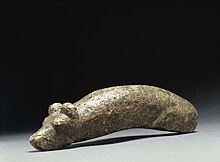 Stone Age bear head gavel found in Paltamo, Kainuu[27][28]
Stone Age bear head gavel found in Paltamo, Kainuu[27][28]
In the Bronze Age permanent all-year-round cultivation and animal husbandry spread, but the cold climate phase slowed the change.[29] The Seima-Turbino phenomenon brought the first bronze artefacts to the region and possibly also the Finno-Ugric languages.[29][30] Commercial contacts that had so far mostly been to Estonia started to extend to Scandinavia. Domestic manufacture of bronze artefacts started 1300 BC.[31]
In the Iron Age population grew. Finland Proper was the most densely populated area. Commercial contacts in the Baltic Sea region grew and extended during the eighth and ninth centuries. Main exports from Finland were furs, slaves, castoreum, and falcons to European courts. Imports included silk and other fabrics, jewelry, Ulfberht swords, and, in lesser extent, glass. Production of iron started approximately in 500 BC.[32] At the end of the ninth century, indigenous artefact culture, especially weapons and women's jewelry, had more common local features than ever before. This has been interpreted to be expressing common Finnish identity.[33]
An early form of Finnic languages spread to the Baltic Sea region approximately 1900 BC. Common Finnic language was spoken around Gulf of Finland 2000 years ago. The dialects from which the modern-day Finnish language was developed came into existence during the Iron Age.[34] Although distantly related, the Sami people retained the hunter-gatherer lifestyle longer than the Finns. The Sami cultural identity and the Sami language have survived in Lapland, the northernmost province.
The name Suomi (Finnish for 'Finland') has uncertain origins, but a common etymology with saame (the Sami) has been suggested.[35][36] In the earliest historical sources, from the 12th and 13th centuries, the term Finland refers to the coastal region around Turku. This region later became known as Finland Proper in distinction from the country name Finland.[37] (See also Etymology of Finns.)
Swedish era
Main article: Finland under Swedish rule
The 12th and 13th centuries were a violent time in the northern Baltic Sea. The Livonian Crusade was ongoing and the Finnish tribes such as the Tavastians and Karelians were in frequent conflicts with Novgorod and with each other. Also, during the 12th and 13th centuries several crusades from the Catholic realms of the Baltic Sea area were made against the Finnish tribes. Danes waged at least three crusades to Finland, in 1187 or slightly earlier,[38] in 1191 and in 1202,[39] and Swedes, possibly the so-called second crusade to Finland, in 1249 against Tavastians and the third crusade to Finland in 1293 against the Karelians. The so-called first crusade to Finland, possibly in 1155, is most likely an unreal event.[40]
As a result of the crusades (mostly with the second crusade led by Birger Jarl) and the colonization of some Finnish coastal areas with Christian Swedish population during the Middle Ages,[41] Finland gradually became part of the kingdom of Sweden and the sphere of influence of the Catholic Church.[42] Under Sweden, Finland was annexed as part of the cultural order of Western Europe.[43] Now lying within Helsinki, Suomenlinna is a UNESCO World Heritage Site consisting of an inhabited 18th-century sea fortress built on six islands. It is one of Finland's most popular tourist attractions.
Now lying within Helsinki, Suomenlinna is a UNESCO World Heritage Site consisting of an inhabited 18th-century sea fortress built on six islands. It is one of Finland's most popular tourist attractions.
Swedish was the dominant language of the nobility, administration, and education; Finnish was chiefly a language for the peasantry, clergy, and local courts in predominantly Finnish-speaking areas. During the Protestant Reformation, the Finns gradually converted to Lutheranism.[44]
In the 16th century, a bishop and Lutheran Reformer Mikael Agricola published the first written works in Finnish;[45] and Finland's current capital city, Helsinki, was founded by King Gustav Vasa in 1555.[46] The first university in Finland, the Royal Academy of Turku, was established by Queen Christina of Sweden at the proposal of Count Per Brahe in 1640.[47][48]
The Finns reaped a reputation in the Thirty Years' War (1618–1648) as a well-trained cavalrymen called "Hakkapeliitta".[49] Finland suffered a severe famine in 1695–1697, during which about one third of the Finnish population died,[50] and a devastating plague a few years later.
In the 18th century, wars between Sweden and Russia twice led to the occupation of Finland by Russian forces, times known to the Finns as the Greater Wrath (1714–1721) and the Lesser Wrath (1742–1743).[51][50] It is estimated that almost an entire generation of young men was lost during the Great Wrath, due mainly to the destruction of homes and farms, and the burning of Helsinki.[52]
Grand Duchy of Finland
Main article: Grand Duchy of Finland
The Swedish era ended in the Finnish War in 1809. On 29 March 1809, having been taken over by the armies of Alexander I of Russia, Finland became an autonomous Grand Duchy in the Russian Empire with the recognition given at the Diet held in Porvoo. This situation lasted until the end of 1917.[51] In 1812, Alexander I incorporated the Russian Vyborg province into the Grand Duchy of Finland. In 1854, Finland became involved in Russia's involvement in the Crimean War, when the British and French navies bombed the Finnish coast and Åland during the so-called Åland War.[53] Edvard Isto, The Attack, 1899. The Russian eagle is attacking the Finnish Maiden, trying to steal her book of laws.
Edvard Isto, The Attack, 1899. The Russian eagle is attacking the Finnish Maiden, trying to steal her book of laws.
Though the Swedish language was still widely spoken, during this period the Finnish language began to gain more recognition. From the 1860s onwards, a strong Finnish nationalist movement known as the Fennoman movement grew. One of its most prominent leading figures of the movement was the philosopher and politician J. V. Snellman, who pushed for the stabilization of the status of the Finnish language and its own currency, the Finnish markka, in the Grand Duchy of Finland.[53][54] Milestones included the publication of what would become Finland's national epic – the Kalevala – in 1835, and the Finnish language's achieving equal legal status with Swedish in 1892. In the spirit of the notion of Adolf Ivar Arwidsson (1791–1858) – "we are not Swedes, we do not want to become Russians, let us therefore, be Finns" – a Finnish national identity was established.[55] Still there was no genuine independence movement in Finland until the early 20th century.[56]
The Finnish famine of 1866–1868 occurred after freezing temperatures in early September ravaged crops,[57] and it killed approximately 15% of the population, making it one of the worst famines in European history. The famine led the Russian Empire to ease financial regulations, and investment rose in the following decades. Economic development was rapid.[58] The gross domestic product (GDP) per capita was still half of that of the United States and a third of that of Britain.[58]
From 1869 until 1917, the Russian Empire pursued a policy known as the "Russification of Finland". This policy was interrupted between 1905 and 1908. In 1906, universal suffrage was adopted in the Grand Duchy of Finland. However, the relationship between the Grand Duchy and the Russian Empire soured when the Russian government made moves to restrict Finnish autonomy. For example, universal suffrage was, in practice, virtually meaningless, since the tsar did not have to approve any of the laws adopted by the Finnish parliament. The desire for independence gained ground, first among radical liberals[59] and socialists, driven in part by a declaration called the February Manifesto by the last tsar of the Russian Empire, Nicholas II, on 15 February 1899.[60]
Civil war and early independence
Main articles: Independence of Finland and Finnish Civil War
After the 1917 February Revolution, the position of Finland as a part of the Russian Empire was questioned, mainly by Social Democrats. The Finnish Parliament, controlled by social democrats, passed the so-called Power Act to give the highest authority to the Parliament. This was rejected by the Russian Provisional Government which decided to dissolve the Parliament.[61] New elections were conducted, in which right-wing parties won with a slim majority. Some social democrats refused to accept the result and still claimed that the dissolution of the parliament (and thus the ensuing elections) were extralegal. The two nearly equally powerful political blocs, the right-wing parties, and the social-democratic party were highly antagonized. Finnish military leader and statesman C. G. E. Mannerheim as general officer leading the White Victory Parade at the end of the Finnish Civil War in Helsinki, 1918
Finnish military leader and statesman C. G. E. Mannerheim as general officer leading the White Victory Parade at the end of the Finnish Civil War in Helsinki, 1918
The October Revolution in Russia changed the geopolitical situation once more. Suddenly, the right-wing parties in Finland started to reconsider their decision to block the transfer of the highest executive power from the Russian government to Finland, as the Bolsheviks took power in Russia. The right-wing government, led by Prime Minister P. E. Svinhufvud, presented the Declaration of Independence on 4 December 1917, which was officially approved on 6 December, by the Finnish Parliament. The Russian Soviet Federative Socialist Republic (RSFSR), led by Vladimir Lenin, recognized independence on 4 January 1918.[62]
On 27 January 1918 the government began to disarm the Russian forces in Pohjanmaa. The socialists gained control of southern Finland and Helsinki, but the White government continued in exile from Vaasa.[63][64] This sparked the brief but bitter civil war. The Whites, who were supported by Imperial Germany, prevailed over the Reds,[65] and their self-proclaimed Finnish Socialist Workers' Republic.[66] After the war, tens of thousands of Reds were interned in camps, where thousands were executed or died from malnutrition and disease. Deep social and political enmity was sown between the Reds and Whites and would last until the Winter War and even beyond.[67][68] The civil war and the 1918–1920 activist expeditions called "Kinship Wars" into Soviet Russia strained Eastern relations.[69][70]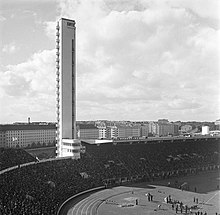 Helsinki Olympic Stadium in 1938
Helsinki Olympic Stadium in 1938
After brief experimentation with monarchy, when an attempt to make Prince Frederick Charles of Hesse King of Finland was unsuccessful, Finland became a presidential republic, with K. J. Ståhlberg elected as its first president in 1919. As a liberal nationalist with a legal background, Ståhlberg anchored the state in liberal democracy, supported the rule of law, and embarked on internal reforms.[71] Finland was also one of the first European countries to strongly aim for equality for women, with Miina Sillanpää serving in Väinö Tanner's cabinet as the first female minister in Finnish history in 1926–1927.[72] The Finnish–Russian border was defined in 1920 by the Treaty of Tartu, largely following the historic border but granting Pechenga (Finnish: Petsamo) and its Barents Sea harbour to Finland.[51] Finnish democracy did not experience any Soviet coup attempts and likewise survived the anti-communist Lapua Movement.
In 1917, the population was three million. Credit-based land reform was enacted after the civil war, increasing the proportion of the capital-owning population.[58] About 70% of workers were occupied in agriculture and 10% in industry.[73]
World War II
Main article: Finland during World War II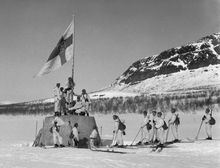 Finnish troops raise a flag on the three-country cairn in April 1945 at the close of the World War II in Finland.
Finnish troops raise a flag on the three-country cairn in April 1945 at the close of the World War II in Finland.
The Soviet Union launched the Winter War on 30 November 1939 in an effort to annex Finland.[74] The Finnish Democratic Republic was established by Joseph Stalin at the beginning of the war to govern Finland after Soviet conquest.[75] The Red Army was defeated in numerous battles, notably at the Battle of Suomussalmi. After two months of negligible progress on the battlefield, as well as severe losses of men and materiel, the Soviets put an end to the Finnish Democratic Republic in late January 1940 and recognized the legal Finnish government as the legitimate government of Finland.[76] Soviet forces began to make progress in February and reached Vyborg in March. The fighting came to an end on 13 March 1940 with the signing of the Moscow Peace Treaty. Finland had successfully defended its independence, but ceded 9% of its territory to the Soviet Union.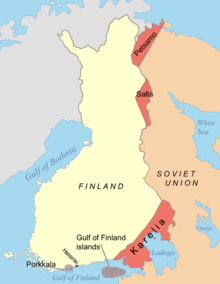 Areas ceded by Finland to the Soviet Union during World War II. The Porkkala land lease was returned to Finland in 1956.
Areas ceded by Finland to the Soviet Union during World War II. The Porkkala land lease was returned to Finland in 1956.
Hostilities resumed in June 1941 with the Continuation War, when Finland aligned with Germany following the latter's invasion of the Soviet Union; the primary aim was to recapture the territory lost to the Soviets scarcely one year before.[77] Finnish forces occupied East Karelia from 1941 to 1944. Finnish resistance to the Vyborg–Petrozavodsk offensive in the summer of 1944 led to a standstill, and the two sides reached an armistice. This was followed by the Lapland War of 1944–1945, when Finland fought retreating German forces in northern Finland. Famous war heroes of the aforementioned wars include Simo Häyhä,[78][79] Aarne Juutilainen,[80] and Lauri Törni.[81]
The Armistice and treaty signed with the Soviet Union in 1944 and 1948 included Finnish obligations, restraints, and reparations, as well as further Finnish territorial concessions in addition to those in the Moscow Peace Treaty. As a result of the two wars, Finland ceded Petsamo, along with parts of Finnish Karelia and Salla; this amounted to 12% of Finland's land area, 20% of its industrial capacity, its second-largest city, Vyborg (Viipuri), and the ice-free port of Liinakhamari (Liinahamari). Almost the whole Finnish population, some 400,000 people, fled these areas. Finland lost 97,000 soldiers and was forced to pay war reparations of $300 million ($4 billion in 2022); nevertheless, it avoided occupation by Soviet forces and managed to retain its independence.
For a few decades after 1944, the Communists were a strong political party. The Soviet Union persuaded Finland to reject Marshall Plan aid. However, in the hope of preserving Finland's independence, the United States provided secret development aid and helped the Social Democratic Party.[82]After the war
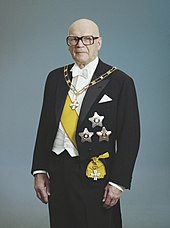 Urho Kekkonen was Finland's longest-serving president in 1956–1982.
Urho Kekkonen was Finland's longest-serving president in 1956–1982.
Establishing trade with the Western powers, such as the United Kingdom, and paying reparations to the Soviet Union produced a transformation of Finland from a primarily agrarian economy to an industrialized one. Valmet (originally a shipyard, then several metal workshops) was founded to create materials for war reparations. After the reparations had been paid off, Finland continued to trade with the Soviet Union in the framework of bilateral trade.
In 1950, 46% of Finnish workers worked in agriculture and a third lived in urban areas.[83] The new jobs in manufacturing, services, and trade quickly attracted people to the towns. The average number of births per woman declined from a baby boom peak of 3.5 in 1947 to 1.5 in 1973.[83] When baby boomers entered the workforce, the economy did not generate jobs quickly enough, and hundreds of thousands emigrated to the more industrialized Sweden, with emigration peaking in 1969 and 1970.[83] Finland took part in trade liberalization in the World Bank, the International Monetary Fund, and the General Agreement on Tariffs and Trade. The Finlandia Hall, designed by Alvar Aalto, where the president Urho Kekkonen hosted the Conference on Security and Co-operation in Europe in 1975.
The Finlandia Hall, designed by Alvar Aalto, where the president Urho Kekkonen hosted the Conference on Security and Co-operation in Europe in 1975.
Officially claiming to be neutral, Finland laid in the grey zone between the Western countries and the Soviet bloc during the Cold War. The military YYA Treaty (Finno-Soviet Pact of Friendship, Cooperation and Mutual Assistance) gave the Soviet Union some leverage in Finnish domestic politics. This was extensively exploited by president Urho Kekkonen against his opponents. He maintained an effective monopoly on Soviet relations from 1956 on, which was crucial for his continued popularity. In politics, there was a tendency to avoid any policies and statements that could be interpreted as anti-Soviet. This phenomenon was given the name "Finlandization" by the West German press.[84]
Finland maintained a market economy. Various industries benefited from trade privileges with the Soviets. Economic growth was rapid in the postwar era, and by 1975 Finland's GDP per capita was the 15th-highest in the world. In the 1970s and 1980s, Finland built one of the most extensive welfare states in the world. Finland negotiated with the European Economic Community (EEC, a predecessor of the European Union) a treaty that mostly abolished customs duties towards the EEC starting from 1977. In 1981, President Urho Kekkonen's failing health forced him to retire after holding office for 25 years.
Miscalculated macroeconomic decisions, a banking crisis, the collapse of its largest trading partner (the Soviet Union), and a global economic downturn caused a deep early 1990s recession in Finland. The depression bottomed out in 1993, and Finland saw steady economic growth for more than ten years.[85] After the collapse of the Soviet Union, Finland began increasing integration with the West.[86] Finland joined the European Union in 1995, and the Eurozone in 1999. Much of the late 1990s economic growth was fueled by the success of the mobile phone manufacturer Nokia.[43]
21st century
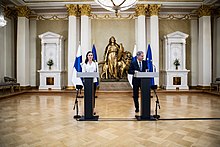 Prime Minister Sanna Marin and President Sauli Niinistö at the press conference announcing Finland's intent to apply to NATO on 15 May 2022
Prime Minister Sanna Marin and President Sauli Niinistö at the press conference announcing Finland's intent to apply to NATO on 15 May 2022
The Finnish population elected Tarja Halonen in the 2000 Presidential election, making her the first female President of Finland.[87] Financial crises paralysed Finland's exports in 2008, resulting in weaker economic growth throughout the decade.[88][89] Sauli Niinistö has subsequently been elected the President of Finland since 2012.[90]
Finland's support for NATO rose enormously after the 2022 Russian invasion of Ukraine. Prior to February 2022, polling showed a narrow but definitive majority in opposition to NATO membership;[91] by April, a supermajority were in favor of membership.[92][93][94][95] On 11 May 2022, Finland entered into a mutual security pact with the United Kingdom.[96] On 12 May, Finland's president and prime minister called for NATO membership "without delay".[97] Subsequently, on 17 May, the Parliament of Finland decided by a vote of 188–8 that it supported Finland's accession to NATO.[98] Finland became a member of NATO on 4 April 2023.[99]
Geography
Main article: Geography of Finland
See also: List of cities and towns in Finland, List of lakes of Finland, List of national parks of Finland, and Environmental issues in Finland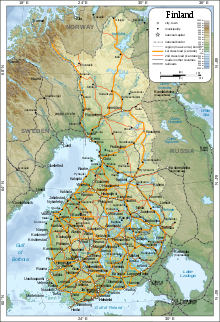 Topographic map of Finland
Topographic map of Finland Northern lights are most common in Lapland in winter time.
Northern lights are most common in Lapland in winter time.
Lying approximately between latitudes 60° and 70° N, and longitudes 20° and 32° E, Finland is one of the world's northernmost countries. Of world capitals, only Reykjavík lies more to the north than Helsinki. The distance from the southernmost point – Hanko in Uusimaa – to the northernmost – Nuorgam in Lapland – is 1,160 kilometres (720 mi). Enontekiö which includes part of the Scandinavian Mountains
Enontekiö which includes part of the Scandinavian Mountains
Finland has about 168,000 lakes (of area larger than 500 m2 or 0.12 acres) and 179,000 islands.[100] Its largest lake, Saimaa, is the fourth largest in Europe. The Finnish Lakeland is the area with the most lakes in the country;[14] many of the major cities in the area, most notably Tampere, Jyväskylä and Kuopio, are located near the large lakes. The greatest concentration of islands is found in the southwest, in the Archipelago Sea between continental Finland and the main island of Åland.
Much of the geography of Finland is a result of the Ice Age. The glaciers were thicker and lasted longer in Fennoscandia compared with the rest of Europe. The eroding effects have contributed to a mostly flat landscape in Finland, characterized by hills. However, in the northern regions, including areas bordering the Scandinavian Mountains, the terrain features mountainous elevations. At 1,324 metres (4,344 ft), Halti is the highest point in Finland. It is found in the north of Lapland at the border between Finland and Norway. The highest mountain whose peak is entirely in Finland is Ridnitšohkka at 1,316 m (4,318 ft), directly adjacent to Halti. There are some 187,888 lakes in Finland larger than 500 square metres and 75,818 islands of over 0,5 km2 area, leading to the denomination "the land of a thousand lakes".[13] Picture of Lake Pielinen in North Karelia.
There are some 187,888 lakes in Finland larger than 500 square metres and 75,818 islands of over 0,5 km2 area, leading to the denomination "the land of a thousand lakes".[13] Picture of Lake Pielinen in North Karelia.
The retreating glaciers have left the land with morainic deposits in formations of eskers. These are ridges of stratified gravel and sand, running northwest to southeast, where the ancient edge of the glacier once lay. Among the biggest of these are the three Salpausselkä ridges that run across southern Finland.
Having been compressed under the enormous weight of the glaciers, terrain in Finland is rising due to the post-glacial rebound. The effect is strongest around the Gulf of Bothnia, where land steadily rises about 1 cm (0.4 in) a year. As a result, the old sea bottom turns little by little into dry land: the surface area of the country is expanding by about 7 square kilometres (2.7 sq mi) annually.[101] Relatively speaking, Finland is rising from the sea.[102]
The landscape is covered mostly by coniferous taiga forests and fens, with little cultivated land. Of the total area, 10% is lakes, rivers, and ponds, and 78% is forest. The forest consists of pine, spruce, birch, and other species.[103] Finland is the largest producer of wood in Europe and among the largest in the world. The most common type of rock is granite. It is a ubiquitous part of the scenery, visible wherever there is no soil cover. Moraine or till is the most common type of soil, covered by a thin layer of humus of biological origin. Podzol profile development is seen in most forest soils except where drainage is poor. Gleysols and peat bogs occupy poorly drained areas.



















![[ℕ𝕖𝕧𝕖𝕣] 𝕊𝕖𝕝𝕝 𝕐𝕠𝕦𝕣 𝔹𝕚𝕥𝕔𝕠𝕚𝕟 - 📈ALT season 40% vs No ALT season 60%📉](https://cdn.bulbapp.io/frontend/images/d2fb6be9-79f1-42ad-b3c2-b55996aa9941/1)
